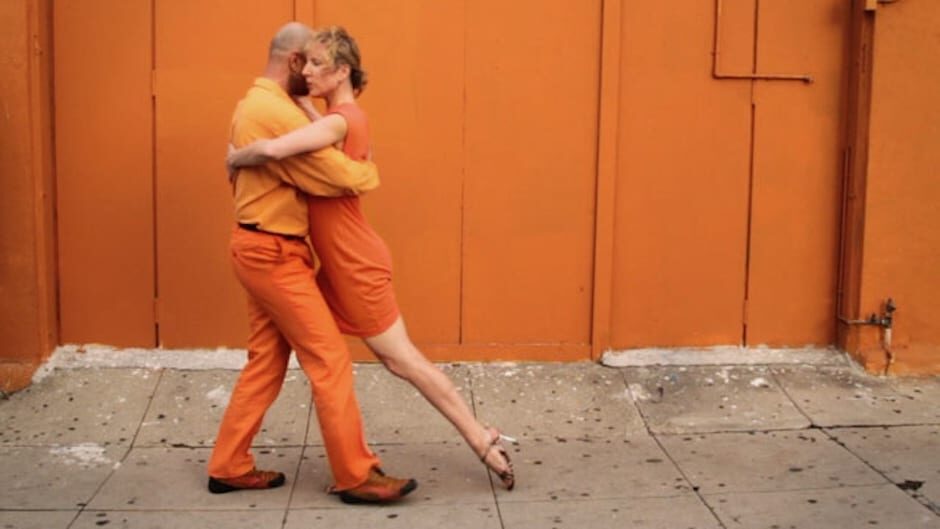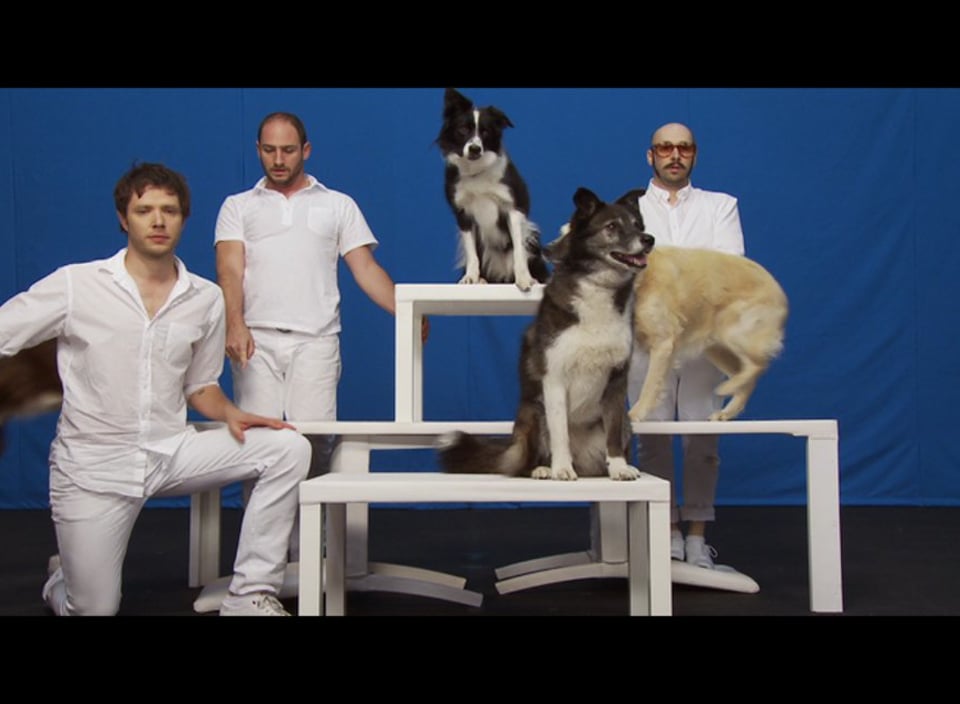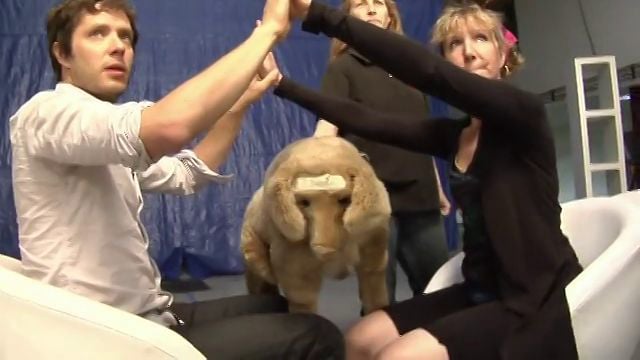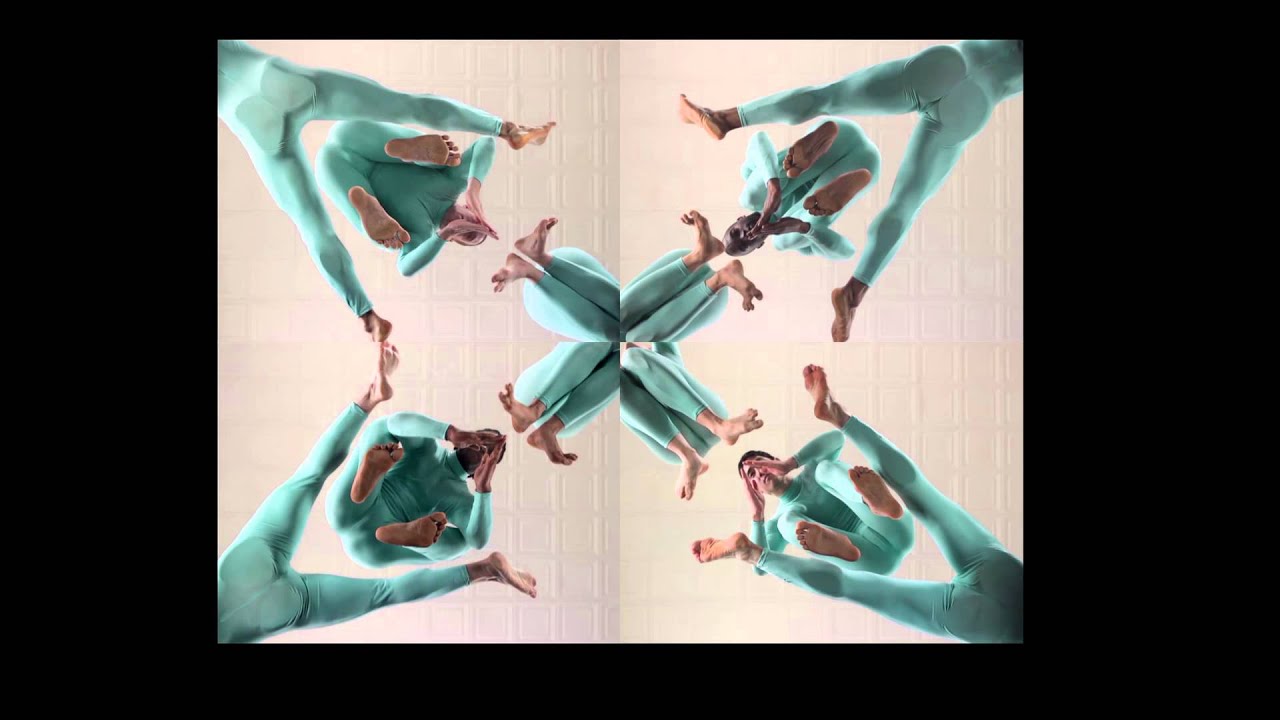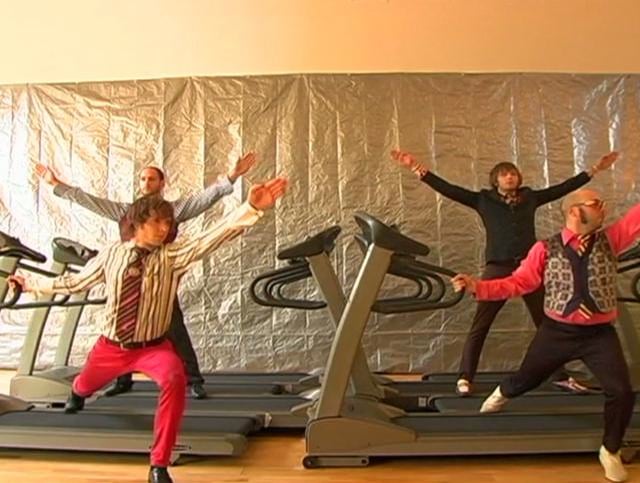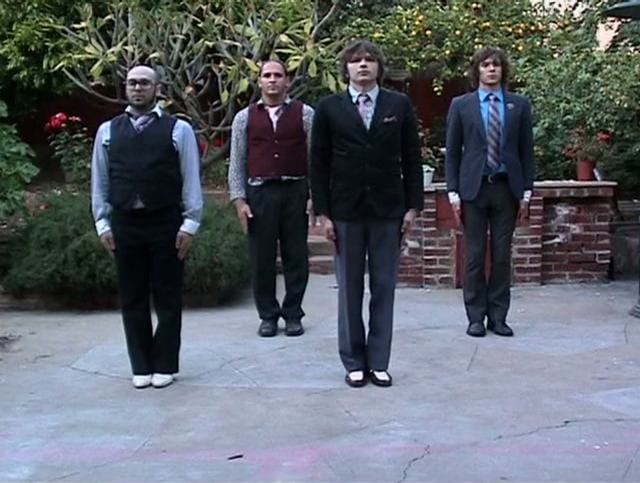Behind every great band there’s a great woman, or so the saying goes, and indie rockers OK Go are no exception. Their fun-infused choreographed dance and dogs wonders have delighted gazillions online, with just the right blend of will-they-won’t-they tension and relief to keep viewers enthralled. Driving many of the band’s biggest viral successes has been dancer, director and choreographer Trish Sie, sister of the band’s lead singer Damian Kulash. It’s her blend of joyous controlled chaos that’s had us gawking into our browsers, from conveyor belt dance workouts to kaleidoscopic Google Experiments.
OnePointFour caught up with Trish from LA after the release of her most recent video for OK Go, Skyscrapers – her first foray in front of the camera for an elegant dance of life that balances colour and emotion in harmonious union. (See above).
We HAVE to ask – are the three single take promos you’ve made with OK GO really single take?! No secret stitching in the edit?!
Yes, I did three single-take videos with OK Go: A Million Ways, Here It Goes Again, White Knuckles, and ALL OF THEM (even the dog one!) are truly uncut with no secret cheats. We were pretty sure people would think the dog one was a trick, so we actually shot the entire room wide wide angles so you can see how we did it and verify that we did, indeed, get 14 dogs and 4 band members to dance together for three and half minutes with no edits. It took us about a 124 tries, but we really did do it. (See all work in Related Content).
How did that first collaboration on A Million Ways come about? And is it true the video was never intended to be the official video?
A Million Ways truly was not intended to be a video. The band had been known for their on-stage dances, which they performed at the end of each live show, and they needed a new dance when their second album came out. So I choreographed it with them and we practiced a lot in Damian’s living room. When the dance was feeling pretty badass and ready to go out on the road, we taped it to see what it looked like, to make sure they were ready to show it to their audiences.
I mean, we hadn’t been practicing it in a real dance studio with mirrors or anything, so they really had no idea what it looked like all put together. Once they started doing the dance at their live shows, fans started asking for it on video. Then someone got a hold of the old practice video we had filmed, which turned into a little mini-online phenomenon at the time, and eventually the band just decided it may as well be “the video” for that song… a song which, if I recall correctly, was never even slated to be a single on the record.
Did you have any inkling that Here It Goes Again would go mental online? Why do you think people fell in love with it to the extent they did?
Here It Goes again was our way of challenging ourselves to top A Million Ways. At this point, making weird little dances was something we had been doing a LONG time (my brother – lead singer Damian – and I grew up staging our own outlandish dance numbers for anyone and everyone who would watch (including our carpool, our cousins, our Legos, our cat, whatever). And now the band had a few pretty cult-y dance numbers of their own. It was time to up the ante.
We went into Here It Goes Again with the express intent of making something that blew everything else we had done out of the water, mostly for our own amusement. At that point, “clicks” and “hits” and “viral status” was really not part of the equation for most people. YouTube was brand new. No one had any idea that something like what happened with the treadmill video would or could ever happen. So… NO. No, we had no idea of the extent to this would change everything for the band and for me. However, that said, when we finished the dance, shot it and watched it back, we DID feel pretty happy about it. We were satisfied. We were pretty sure it was the most volcanically excellent thing we had ever made. And we certainly hoped other people would love it, too.
Do you have a standard approach to devising choreography or does it vary entirely from project to project?
I have a standard approach… which is that my approach will vary from project to project. In some instances, I’m very architectural about it, building movement like a structure with very solid rules and boundaries. Other times, I’m more emotional and go-with-the-flowy. And sometimes I let my ideas grow out of the humor or the athleticism of a given situation. But basically, like most people who make stuff, I’m only genuinely interested in things that I’ve never done or seen before, which by definition means that I have no way of knowing what to do when I begin.
Normally I start groping around blindly, using as many non-dance references as I can to inspire myself (art, math formulas, outer space, cookbooks, photography, geometry, mirrors, kaleidoscopes, craft projects, fabric, apeshit things in nature like crystalline structures or flower petals or cells dividing– basically anything under a microscope will get my juices going). But even when the actual creative process is completely different in each case, the two things that all my favorite projects have in common are that they give me time to play and experiment with genuinely creative collaborators.
I need people who think in broad, uncategorized ways, people that have berserk skillsets in specialized fields, yet have enough curiosity and imagination that they aren’t firmly rooted and entrenched in a single “world” of dance, music, film, literature, technology, art, etc. And then I need lots of time and space to play with those people… to try things, to let ideas simmer and stew, to explore every single inch of a given concept and then push the boundaries out further and explore it some more. As long as I have those two things (the people and the time), I feel like you could give me any concept, any set of rules or parameters, any assignment, and together, we can come up with something new and interesting.
On that point, do you have the luxury of rehearsing with the band before each shoot?
Yes – I rehearse a lot with the band before we shoot. It’s a luxury, for sure. But it’s also kind of a necessity. There’s no way in hell we could make the stuff we make in a day. Or even in a couple of days. A Million Ways took a week. Here It Goes Again took ten days. Both White Knuckles and All Is Not Lost were on-and-off for a year each. I think that’s why people are drawn to those videos– you look at that and say, “I don’t care if those people are rockstars or not. They had to have busted their balls to make that.”
A clever idea is one thing, but raw evidence of someone’s compulsive outpouring of blood, sweat and tears is another. It’s universal. We all know it when we see it, we get what it means, we all recognize it, we all respond to it. And that evidence of hard work and sincere effort is related to the attention to detail– without enough time and space, no matter how brilliant or skilled you are, you just can’t give each detail the loving care it deserves.
I can’t stand having to make things in a big rush. Not that total open-endedness is good either. We need deadlines– they push you, they focus you and they provide some constraints that help move and guide the process. But trying to make something truly compelling and artistic and fresh in a single day is a nightmare. It just doesn’t usually happen. If I only have a single day to work with someone or to shoot, I make sure that I spend a hell of a lot of time beforehand doing everything I can to play and explore on my own beforehand. But it’s still not the same.
Has there ever been an idea you’ve tried to execute in your music videos that was just too complicated? Or one you’d like to that your not sure is possible?
I have a lot of ideas that I suspect may not be possible. In fact, that’s always my best gauge for whether an idea is worthwhile or not – if someone smart or legitimate tells me that it’s not possible, then I figure I’m on the right track. Otherwise, it would have been done before… no? I have some complicated large-scale paint-by-number-type visions swimming around in my brain that seem like a big challenge if I can ever get them to work.
I also have a couple of ideas for a few different projects that involve magical trashbins, an entirely crocheted universe, ninjas, Rumpelstiltskin, surly teenagers at a country-western theme park and/or a home for unwed mothers, and Melissa McCarthy. All separate ideas, by the way. All of them seem like long shots, but all of them feel entirely awesome, if someone will let me try.
What has been the most taxing promo you’ve worked on to date?
Honestly, none of the OK Go videos has been taxing because each was like a little dream coming true… I mean, given that I’m a truly nutty dog-lover myself, getting to work with fourteen well-trained dogs in Oregon for weeks on end was a heavenly fantasy. I seriously enjoyed every minute of that. And then for the choreographer in me, getting to collaborate with Pilobolus Dance Theatre (my childhood idols, the dance company that first opened my mind to what was out there in the world of movement and experimentation and fearlessness) on All Is Not Lost was a pinch-me-I-must-be-dreaming moment for me as well.
So it’s really hard to say which OK GO videos have been most difficult because, at the risk of sounding syrupy sweet, they’ve all been genuinely joyful experiences that I feel so grateful to have had. I’ve worked on plenty of projects that have been truly taxing, though. It’s not the hard work that makes them difficult – I like the hard work. What makes certain jobs tough is the circumstances – usually generated by people who don’t understand the way I work, my need for space and time and the fact that I need a specific type of people around me. If I can’t have my people – or worse, if I have the wrong people – it all becomes very labored, the vision gets pulled off-track and the results suffer.
Why do you think people find your videos so endearing? Is it the band’s obvious lack of dance/movement training?! Or the feeling that you’re rooting for them to pull it off while you’re watching?
I think you hit the nail on the head: we’re rooting for people who seem to be trying something outside of their safety zone, putting themselves on the line in a real way that is transparent so we can appreciate the risk and the stakes. I’m delighted by ordinary people doing extraordinary things. It’s very simple. Simple, but requiring a lot of earnest effort and preparation and care. No matter how digital and fancy the world gets, these are things we notice and things that still move people.
All Is Not Lost added a new technical element into the mix with the extra Google Chrome Experiments interface. How did you approach the choreography on this one? It’s like Busby Berkley meets turbocharged internet browsing!
Ha! I love that phrase you just tossed out. The dance definitely developed in close collaboration with the technology. It’s interesting, because my initial concept featured a much larger piece of Plexiglas than the one we ended up using. Turns out that expansive sheets of Plexiglas strong enough to hold twelve jumping/leaping/dancing bodies is prohibitively expensive. So my original visions of these colossal kaleidoscopes and enormous shapes had to be scaled down to fit the smaller glass. Then, when Google Chrome came along and got involved, the prospect of multiple windows allowed us to expand back toward the idea of a larger scale piece again.
The way we spit the dance across the screens was something that took a lot of trial and error, a lot of tests using this radical Bollywood video software that duplicates and makes mirror-images of everything in real time – it was lunacy. But we really didn’t know what would work until we’d tried it a thousand different ways, playing with shapes and speed and density, then flipping everything around and smashing it together and trying it all over again, but this time backwards. Or with three people instead of five. Or with faces instead of feet. Or everything twice as fast or twice as slow.
It comes back to that idea of time and play – it’s so crucial. Some people are able to sit in a room by themselves and imagine the most incredible things out of thin air or out of their own brilliant brain waves. Not me. I need bodies and textures and people tumbling around and music and I need to see four hundred ways to try something before the answers to the puzzle start emerging.
And now your latest project, Skyscrapers, sees you in front of the camera for the first time. How did that come about? And was it strange dancing and directing at the same time?
IT DROVE ME NUTS TO BE IN FRONT OF THE CAMERA! I was pulling my hair out not being able to see what the shots looked like in real time. Everything feels so different when you’re in it – I couldn’t FEEL how it LOOKED. And there is so much more distance between those two things that it seems like – how something feels and how it looks. I felt trapped. It was very claustrophobic for me. I desperately wanted both to be dancing free, with abandon, and also to be seeing it all go down, instead of worrying about my footwork or my eyeline or my dress riding up to show my underwear.
It’s very hard to have any perspective from the front of the camera – you’re in a tiny little microworld, and the more you’re able to lose yourself in that world, the more you can stay contained in that space and the less you worry about technical details or what’s happening outside your tiny little ecosystem, the better your performance will be. But that’s the opposite of a director, who needs to see everything, who can’t lose sight of the forest for the trees.
I firmly believe that a performer has to implicitly trust her director, as her conduit to the outside world, to guide her through the performance so she can stay focused. She needs to know that this person will make everything they imagine in their heads – everything they feel – come out looking the way they want it to look, even when there’s that disconnect between how it feels in the moment and how the camera sees it. It felt impossible to me to play both those roles at the same time. It felt like conflicting parts of my brain were trying to work at the same time. I don’t know how people do it– handle both sides of the camera at once. Wow.
LINKS:
